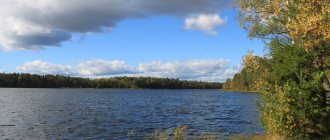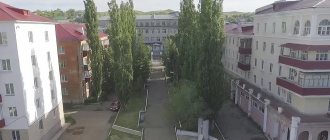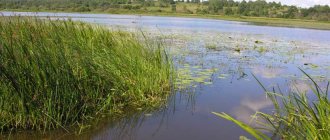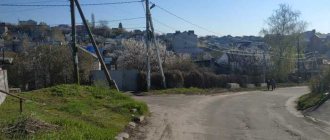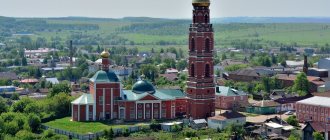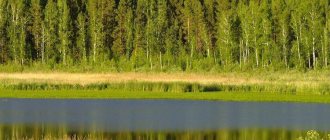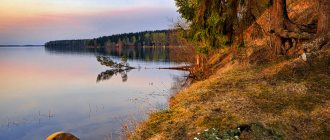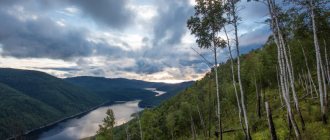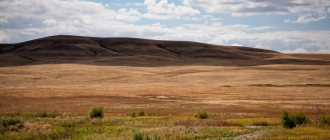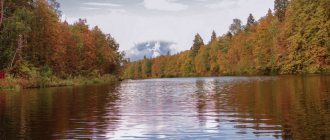The Vologda region was formed in 1937 and has more than three thousand cultural, architectural and historical monuments. Several cities are included in the list of cultural heritage of Russia, including Veliky Ustyug, Belozersk, Ustyuzhna.
The presence of mineral and peat springs contributes to the development of therapeutic and preventive sanatoriums for adults and children.
The Valdai glaciation contributed to the emergence of ancient lakes rich in fish. Due to this and the large number of forests, so-called rural tourism is being developed here, which includes hunting and fishing.
For ease of route planning, we have marked all mentioned cities and attractions on the map of the region:
Famous rivers and lakes of the Vologda region
This region is one of the richest in water resources in Russia. Many of its rivers originate in neighboring regions, others are born here and are included in the list of the most beautiful water areas in the country.
White Lake
- Coordinates on the map: 60.176882, 37.646238.
At dusk, when the stars light up in the sky, or in bad weather, when the sun hides behind lead clouds, the entire surface of the lake begins to glow with phosphorescent light. This effect is produced by fine white clay that rises from the bottom and mixes with water.
Because of this, the lake is called White. Although some linguists believe that its name is a literal translation from the Vepsian language.
This is one of the largest reservoirs not only in the Vologda region, but also in Europe. Its area is almost 1290 square meters. km. The lake has long been famous for its abundance of fish, especially its northern shore: sterlet, sturgeon, roach, pike, bream. Some of them, with the exception of sturgeon, live here and now
Kubenskoye Lake
- GPS coordinates: 59.640575, 39.442751.
One of the most picturesque lakes in the Vologda region is Kubenskoye. About 30 rivers flow into it. One of them is Kubena, after whom he was named. And only Sukhona flows out.
The reservoir is navigable. It is believed that it was precisely this that Peter I initially wanted to use for the construction of his flotilla. But I changed my mind because of the shallow depth. For the same reason, fishing on the lake can only be done from a boat or in the winter when the ice freezes. There is plenty of fish here, especially perch. And there is even nelma, which is very rare in our time. Previously, it was considered a “royal” fish and could only be found on the tables of the nobility.
The lake is also famous for the fact that in the middle of it there is a small island on which the oldest monastery of the Russian North is located - Spaso-Kamenny. The monastery, built in 1260 by Gleb Vasilkovich, was destroyed during Soviet times. But now work is underway to restore the ancient temple. You can get to the island along a narrow embankment or by boat.
For tourists, bases and rest houses, as well as campsites, have been built on the banks of the reservoir. Those who like to relax with savages were less fortunate. Where the coast is not landscaped, everything is overgrown with grass and algae.
Sukhona River
- Coordinates: 60.029490, 43.060438.
“River with a dry bottom” - this is the name given to it by the Slavs who settled on its banks in the 9th century - a historical place. It was known to people back in 17 thousand BC. e., as a place suitable for living. It was here that the Finno-Ugrians and Aryans became related, giving birth to new tribes. Vepsians, Meryas, Komi, Sami, and later Slovenes, the same ones who founded Novgorod.
The largest and most beautiful river in the region has always been mysterious. The nature of its flow is inconsistent; narrowings occur in the lower reaches, and not in the upper reaches, like other rivers. If the current constantly moves in a north-easterly direction, then during a flood it can sharply reverse.
As a tourist attraction, Sukhona will interest any person. Wild beach holidays, visits to boarding houses and tourist centers, fishing spots and hunting grounds - all this is on the banks of the ancient northern river. The bravest ones can try rafting or kayaking along the numerous rapids.
Sitskoye Lake
- Coordinates: 59.824959, 38.870830.
The lake, located near the Russian North park, is loved by both fishermen and tourists. Its shallow depth and powerful channels that prevent the water from blooming make it very attractive for recreation.
Uloma swamp
- Coordinates: 59.010938, 37.186992.
The reservoir, located on the territory of 4 districts of the Vologda region, is one of the three largest wetland systems in Europe. It was formed approximately 12 thousand years ago as a result of the shallowing of an ancient lake, but swamp-forming processes continue today.
Its development began in the middle of the 20th century. It was assumed that peat would become the main fuel for the Cherepovets State District Power Plant, but it turned out to be unsuitable for combustion. Then it was decided to preserve part of this ecosystem in its original form.
The Uloma swamp is a real book of nature. Here you can find trees, shrubs, grasses and mosses. Many of them, such as English sundew, common water lily, snow-white water lily, etc., are listed in the Red Book of Russia.
Ornithologists also consider it one of the most favorable habitats for waterfowl. The largest population of black-throated geese within the European part of Russia is observed here, as well as peregrine falcons, golden eagles, osprey, golden plover, etc.
Cultural and educational holiday in Vologda
There are a lot of interesting places where you should go in Vologda to fill your leisure time with vivid impressions and broaden your horizons. The city has several remarkable museums; in the evenings, theaters invite fans of Melpomene to see the art.
Lace Museum
- Opening hours: from Wednesday to Sunday inclusive, from 10:00 to 17:00.
- Ticket price: adult 150 rubles, reduced price 70 rubles, for preschool children 50 rubles.
- Telephone.
- Address: Kremlin Square, 12. Transport stop "Center".
When you come to the city, you simply cannot ignore the colorful museum. Exquisite lace, created by the hands of skilled craftswomen, has glorified Vologda throughout the world. Why miss a great opportunity to see all this splendor with your own eyes? The exhibitions of the institution, occupying an area of 1.5 thousand m², tell about the history and evolution of a unique artistic craft from its inception to the present day. During the excursion, tourists will see many exhibits. Among them there is not only stunning Vologda lace, but also creations made of silver or gilded thread, made by needlewomen from Germany, Slovakia, Poland, and Spain in the 17th–19th centuries.
House-Museum of Peter I
- Opening hours: from Wednesday to Sunday inclusive, from 10:00 to 17:30.
- Ticket price: adult 80 rubles, reduced price 50 rubles, for preschool children 40 rubles.
- Telephone.
- Address: Sovetsky Prospekt, 47. Transport stop “Yashina Street”.
The first Russian emperor visited Vologda quite often. On one of these trips, he stayed in a house built for the Dutch merchant Johann Goutman. In 1872, the city authorities bought the building and, after restoration, set up a museum in it dedicated to Peter I. The house is also interesting in itself as an architectural monument. The historical interior has been recreated in the premises; the stoves lined with tiles have been preserved. Among hundreds of museum exhibits, visitors will see the death mask of Peter I, clothes that the emperor wore during his lifetime, antique furniture, a beater with the royal seal, and an ancient musket. A cannon from the Peter the Great era is installed in front of the museum building.
Art Gallery
The exhibition halls of the regional art gallery are located in the building of the Resurrection Cathedral - a stunning monument of Russian Baroque architecture, erected in the last third of the 18th century. The collection of the institution, founded in 1952, consists of several thousand works by masters of painting, graphics, sculpture, and decorative and applied arts. The gallery halls display paintings by A. Benois, B. Kustodiev, I. Aivazovsky, K. Korovin, I. Levitan. Connoisseurs will especially enjoy the unique collection of bookplates.
City Drama Theater
Last year, the regional Drama, one of the oldest Russian theaters, opened its 168th season. Over its long history, the theater has known periods of ups and downs. Actors performed on its stage who later made careers on the stages of capital cities. The current generation of artists constantly delights audiences with bright performances of various genres, including colorful productions for children. Performances often attract full houses. Since 1991, the most interesting International Festival of Theater Arts “Voices of History” has been held in Vologda.
Vologda region: beautiful mountains and rocks
Hilly hills and mountain peaks are one of the features of the relief. Many of them are completely unremarkable, but there are others that amaze with their beauty and unusualness.
Mount Andoma
- Coordinates: 61.282282, 36.365155.
The multi-colored steep slope towering above Lake Onega is one of the most beautiful places in the region. Here sediments that are millions of years old come to the surface: red, green, purple sandstones.
They even contain fossilized trees and ancient fish covered with shells. The mountain is part of the Great Andoma Upland and has a height of 85 m above sea level. It was formed as a result of the movement of a large glacier.
Mount Maura
- Coordinates: 59.866807, 38.278809.
The mountain, unremarkable at first glance, already at the stage of ascent turns into a bastion of tranquility. And at its top, even the most tired traveler begins to feel an extraordinary surge of energy and vigor. It seems that lightness is diffused in the very air around Maura.
This phenomenon is explained by the fact that several water streams intersect at once under the mountain, and such places have always been filled with the energy of life. In addition, this is an excellent observation deck. From the top there is a wonderful view of the Russian North park and the Kirillo-Belozersky Monastery.
Mount Sandyrev
- Coordinates: 59.882586, 38.294504.
Another mountain of the national park is Mount Sandyreva. It differs from other hills in the almost complete absence of vegetation, standing out as a gray spot against the backdrop of a riot of greenery. Thanks to this, the mountain offers wonderful views of all directions. From it you can see the largest islands on Sheksna, the village of Sandyrevo, the village. Goritsy and nearby fields, meadows and forests.
Until 1968, limestone was mined here, as evidenced by two abandoned quarries. Development stopped after Nikolai Barbot de Marny, Doctor of Geological Sciences at the St. Petersburg Mining Institute, compiled a complete description of the unique fossil deposits. Now, due to its conservation status, it is prohibited to conduct any economic activity on the mountain, including grazing.
Mount Malgora
- Coordinates: 60.678056, 35.378611.
The highest point of the Vologda region is located in the Vytegorsky district and has an altitude of 304 m above sea level. This is part of the Vepsian Upland, slightly elongated and consisting of several hills. Its steep slopes are covered with spruce forest. At the foot splashes Malozero with its swampy shores and Malruchey, which received their names from the name of the mountain.
Historical and Ethnographic Museum "Galsky Estate"
In 2009, an interesting museum opened in the city, located in a house considered a masterpiece of wooden architecture in provincial settlements. The house was built by the landowner Kudryavtsev in 1830 on a beautiful spot on the banks of the Sheksna. Later, the Gali nobles became its owners.
Now a museum has been opened in it, conveying the atmosphere of 150 years ago in an interesting exhibition called “Family History, History of Russia,” reflecting the way of life of the Russian nobility. The first floor is occupied by the “Ethnography” exhibition, created from elements of private collections.
Numerous outbuildings have been preserved. Some of them have been restored. For example, you can ride horses in the stables. In the forge, try your hand at the difficult work of a blacksmith. Sitting in the cozy hall of the estate, listen to a chamber concert of artists of the Cherepovets Philharmonic.
Address: Maturinskaya street-28.
A trip around the city's outskirts will complement the list of interesting attractions in the area. The beauty of the Rybinsk Reservoir, the fascinating stories of its creation, legends about the secrets of forest lakes, impenetrable swamps, clear rivers, sparkling fish with silver scales, will definitely invite you to see these places in Russia.
The most beautiful waterfalls in the Vologda region
Sparkling splashes, the sound of thundering water churning boiling white foam - what could be more beautiful than this miracle of nature? Waterfalls in the Vologda region, although small, are very spectacular and impressive.
Padun Waterfall
- Coordinates: 60.891973, 36.572891.
A small 1.5-meter waterfall drowns out all sounds in the area - hence the unusual name. The Tagazhma River is considered one of the most picturesque corners of the Vologda region, and the water cascade is undoubtedly one of its wonders.
A deep, at least 3.5 m, hole with a rocky bottom formed right underneath it. It is especially loved by fishermen, because it is home to huge graylings, and a little further upstream you can catch rainbow trout. You can watch the roaring waterfall at any time of the year.
Vaskin's key
- Coordinates: 60.595060, 45.283031.
The waterfall in the Veliky Ustyug region has been known for more than 300 years. The water passes about 5 m underground, after which it comes to the surface between the villages of Nizhnyaya Tozma and Poldarsa, falling down from a 14-meter height.
According to local legends, it was formed in the place where an imp named Vaska stamped his hoof, angry at people. The impact split the rock into two parts and subsequently a spring began to flow there.
The water in it has amazing properties. Thanks to its carbonate composition, it not only does not destroy the rock, but, on the contrary, strengthens it. The area around the waterfall is colored in all shades of green due to mosses and is classified as a specially protected area.
Home to Santa Claus
For two decades now, one of the oldest cities in the region, Veliky Ustyug, has been welcoming travelers from different parts of the country and from abroad.
At first, only 2 thousand tourists a year visited the estate of the main winter wizard, but ten years later their number exceeded 209 thousand people.
Temple complex - Cathedral courtyard in Veliky Ustyug
People come to Veliky Ustyug to take part in the holidays and admire the beauty of northern nature. Here you can enjoy the silence, look at the cathedrals and temples of the 16th-18th centuries, as well as the ancient St. Michael the Archangel Monastery, which was founded in 1212.
The homeland of Father Frost has become so popular that tours are now organized there both in winter and summer. How did this affect the city's economy? Trade turnover increased 15 times, and unemployment fell sharply.
Lace Museum in Vologda
Sacred sights of the Vologda region
Places revered and sacred in these parts are found at every step. Here everything is given divine significance and meaning.
Vytegorsky boulder
- Coordinates: 60.789314, 37.788152.
The largest stone in the Vologda region is located in the Vytegorsky district. This is a boulder whose shape most closely resembles a pyramid, because all 4 faces of the stone are oriented strictly to the cardinal points. It rises 5 m above the ground, another 4 m remain hidden underground.
Scientists believe that the Vytegorsky boulder was part of the rock during the Ice Age. But how he ended up on the territory of the Vologda region is unknown. Perhaps it came to these regions along with the glacier.
Megaliths in Kovrizhnovo
- Coordinates: 59.792352, 38.265933.
Two flat granite slabs lying on several round stones were discovered at the end of the 20th century near Mount Maura, 100 meters from the shore of the Sheksna. On one of them there is an Orthodox cross and an illegible inscription, apparently some kind of date.
Local residents use the names Dolmens of Belozerye and “holy bowls”. These stones were revered here, and even at the beginning of the last century, prayer services were constantly held near them. Attempts to study the boulders more deeply showed that the image of the cross dates back to the 17th century, but the cult meaning has not yet been unraveled.
Stone Elk
- Coordinates: 59.962398, 42.941910.
Our ancestors thought that the moose was the largest animal in the world. Therefore, a huge boulder in the Sukhona riverbed, very similar to the head of an elk swimming across the river, was named after him.
The 8-meter-long and 4-meter-wide grayish-pink stone rises 2.5 meters above the water, but only at the end of spring, when the ice has completely melted, and in the summer. In autumn, during the season of heavy rains, it is hidden by water. Scientists believe that it had sacred meaning for our ancestors. Perhaps it was an altar on which elk were sacrificed.
The boulder also has another name - “The Tsar’s Table”, associated with Peter I. During one of his travels, the Russian emperor dined directly on it. The huge stone contained not only him, but also his entire retinue.
Stone woman
- Address: Kharovsk, st. Leningradskaya, 7.
A stone with a carved human face was discovered by accident in the Kharovsky district. Idols of this kind are quite common finds. It is believed that they are associated with the cult of ancestors and represent the head of the clan. Pagans usually asked such stones for harvests and childbirth.
The Kharovsky baba weighs about 3 quintals, and its height is almost 120 cm. The approximate age of the idol can be more than 2.5 thousand years. He has clearly distinguishable eyes, nose, mouth, a cross is carved on his chest, shoulder blades and the back of his head.
Similar artifacts have not been found here before, and the surrounding area does not look like pagan sanctuaries. Most likely, the idol was brought here along with sand during the construction of the road. Now it is on display at the Kharovsk Art Museum.
Iron-stone
- Address: Pustosh village, Totemsky district.
It is located near the village of Pustosh, on the left bank of the Edenga. He is not as famous as the Elk, although he is considered more serious in power and reverence. In ancient times there was a sanctuary of Perun here.
Despite its impressive dimensions (about 5 m wide, 2 m high and 8 m long), it is not at all easy to detect. There are huge steps on the east side of the stone. Once there were 12 of them, now there are only five left. And the depression on the southern side is called the trace of God, who sat down here to rest.
Not far from Utyug there is an ancient burial ground, which dates back to the 10th century. Presumably the burial belongs to Chudi, a mysterious Slavic tribe. However, there are no traces of their permanent presence in these places.
Today, the Boulder goes deeper into the ground, and on its surface people more often burn fires and barbecue than pray. But the local old-timers still remember how the old people cast spells on the stone: they covered it with towels and walked around it, whispering incantations and prayers.
Tiunovskoe sanctuary
- Coordinates: 60.413723, 43.694007.
An unusual archeological monument is located in the town of Tarnog, not far from the Korzha River. This is an altar slab and a large stone, which is most often called a “cross”. It looks like an irregularly shaped square, but closer to the top it begins to round. The entire surface of the stone is dotted with strange designs.
There are silhouettes of people, buildings, geometric figures, and letters of the Cyrillic and runic alphabets. Presumably, this is how the tribes who lived in these places in the 14th-16th centuries saw the model of their world. But, interestingly, they still cannot decipher the mysterious signs.
Church of the Assumption of the Blessed Virgin Mary in Nelazi
Architectural monuments of ancient Russian wooden architecture, made without a single nail from beautiful, neat logs, amaze with their grandeur and originality. This is exactly what the church, built in 1694, is like. The architectural style of the church is based on an equal-pointed cross.
The center is decorated with a cross-shaped barrel. Five majestic domes rise above it. From a distance, the church resembles a mysterious ship, forever stuck among the endless fields of the Vologda region. The church is closed for regular services. You can only enter it on holidays.
Address: Nelazskoe village.
Geological natural monuments
Our planet is an amazing place. Day after day, century after century, different events took place: the earth's crust moved, volcanoes erupted, glaciers melted, only to form again after some time. We can see the results of such cataclysms now. And it is very beautiful, like everything created by nature.
Geological outcrop Myakolitsa
- Coordinates: 60.681344, 45.942800.
This natural monument is located on the left bank of the Sukhona. The shore in this place is high, up to 70 m, and steep. Time and wind have done their job, giving it bizarre shapes. But the most interesting thing is that sandy lenses are clearly visible among the Permian red flowers. These discontinuous layers of sand are about 250 million years old.
At the end of the 19th century, a paleontological study was carried out here for the first time and the fossilized remains of ancient reptiles, distant relatives of modern hippopotamuses, were found in the lenses. Some of those finds are now stored in the Vologda Museum-Reserve.
Cape Bull
- Coordinates: 60.660529, 45.718764.
The banks of the Sukhona are places of amazing beauty. Where the Verkhnyaya Erga flows into it, there is one of them - an erosional remnant named Bull. It is generally accepted that it looks like a bull drinking water, but still this name most likely comes from the field of architecture. After all, the “bull” in it is called a pyramidal protrusion that supports bridge supports.
The cape is made up of many layers of limestone and brightly colored marls, in which the fossilized remains of ostracods - lower crustaceans - are found. Limestone was once mined here, and even the old adit has been preserved. But the entrance to it is covered for security reasons.
In 1987, the outlier received the status of a geological natural monument. Now it is protected by the state in order to preserve the unique natural landscape, as well as endangered plant species.
Tract Colored flints
- Coordinates: 60.666983, 45.852027.
The landscape natural monument is located on the right bank of the Sukhona near the village of Krasavino. A geological outcrop 2 km long and 60-70 m high stands almost vertically above the river.
Between the layers of clay and marls there are colored flints interspersed with ornamental stones: amethyst, quartz, calcite. Actually, because of them the natural monument got its name.
The nature of the tract is also protected. Here, on the same territory, European and Siberian species of taiga plants coexist, many of which are listed in the Red Book of Russia and the Vologda region.
Olarevskaya ridge
- Coordinates: 59.383452, 40.078968.
The horseshoe-shaped moraine ridge on the border of the Sokolsky and Vologda regions is a landscape natural monument. Its length is more than 10 km. The Olarevskaya ridge appeared after the Valdai glaciation - the most recent in the northern part of Russia. Even now you can see huge boulders, up to 1.5 meters high, overgrown with lichen. This is all that remains of the glaciers.
The ridge is composed of loams, in which inclusions of igneous rocks, gneiss, and quartzite are found. There are also stones with a small admixture of iron ores. Sometimes they cause magnetic anomalies, causing travelers to wander in circles.
By the way, one of the interesting facts about this place is that most of the boulders are arranged in families: a large stone is Dad, next to it is Mom (slightly smaller) and around there are many small Children. Almost the entire ridge is covered with forest. There are aspen trees, spruce trees, birch trees, and even artificially planted cedar trees.
What to see in Vologda in the Kremlin:
- Bell tower of the Vologda Kremlin
- Saint Sophia Cathedral
- Vologda State Historical, Architectural and Art Museum-Reserve
- Church of the Resurrection of the Vologda Kremlin
- Bishop's Court
- Church of the Nativity of Christ at the Bishop's Courtyard in Vologda
- Pyatnitskaya Tower of the Vologda Kremlin
- Gingerbread house
- Southwestern tower of the Vologda Kremlin.
The Vologda Kremlin is a unique architectural monument, built by order of Ivan IV the Terrible and planned as the future personal residence of the Tsar. But due to historical events this was not destined to come true. Construction work was carried out from 1565 to 1571 under the leadership of the famous engineer of the 16th century - Razmysl Petrov. Even after construction was completed, many structures were still erected and rebuilt over the centuries. Traditionally, the complex of the Vologda Kremlin includes: the Bishop's House, the Resurrection Cathedral, the St. Sophia Cathedral with a bell tower, located outside the Kremlin walls. Among the attractions it is worth seeing the amazing frescoes of the St. Sophia Cathedral, which is a monument of painting of the 17th century. Their total area is about 5000 square meters. meters. Today, tourists and pilgrims can visit the Vologda Kremlin through two entrances: the main one, located between the Bishops' and Resurrection Cathedrals; and the second - the northern side of the stone fence. On the territory of the Kremlin, buildings are haphazardly located, conventionally divided into three courtyards: the central, Consistorsky and utility courtyards. Most of the premises of the bishop's residence and courtyard are used by the Regional Museum-Reserve.
Read more about the structures of the Vologda Kremlin here.
The Vologda Kremlin is located on the Kremlin Square of Vologda - the main square of the city. The ensemble of Kremlin Square includes three churches and a bell tower. Cathedral Hill is located next to the Kremlin. Ivan the Terrible began to build the Kremlin, but the area was built up over several centuries. Therefore, the buildings located here differ from each other in architecture and style. Initially, the pavement of Kremlin Square was wooden. In 1947, for the 800th anniversary of the city, a new stone pavement was laid in place of the old pavement on the square. Both boulevards were restored, and a lawn was installed in the center. In 1957, the pavement on the square was covered with asphalt. In the mid-1970s, traffic through the square was closed. In 1960, for the anniversary exhibition of industry in the Vologda region, a glass pavilion “Mechanical Engineering and Transport” (glass) was built next to the Alexander Nevsky Church, which was dismantled a few years later. In 2006, reconstruction of the square began and was completed in 2007. The area was tiled, and the lawn in the center, on which spruce trees grew, was cleared. The square became pedestrian.
Holy and mineral springs
The Vologda land is very rich in miraculous springs. Each of them has its own legend or tradition. And rumors of healing properties spread far beyond the region.
Shelokhach sulfur springs
- Coordinates: 58.983371, 36.583570.
The group of hydrogen sulfide springs in the floodplain of the Chagodosha River received its name from the nearby settlement - the village of Shelokhach. Today they have been given the status of a hydrological natural monument.
The water in them is slightly mineralized, and, due to the high content of hydrogen sulfide, has medicinal properties. Most often people come to the springs with various skin diseases, radiculitis, rheumatism, etc.
Novsky source
- Coordinates: 59.191667, 39.529167.
Today there is a balneological resort on this site, but the healing spring was discovered completely by accident. In the middle of the 20th century in the village. New on the river bank The sick people began to conduct geological exploration.
For this purpose, a 270-meter well was laid, from which a water fountain unexpectedly began to flow. Chemical analysis showed that the composition and properties of the water are almost identical to the mineral springs of Solvychegodsk or Staraya Russa.
Sources of Dmitry Prilutsky
- Coordinates: 59.172383, 40.642267.
In the Mezhdurechensky district there is a unique natural monument - Dyakonovskaya Polyana. It is considered a place of power and is inextricably linked with the life of Dmitry Prilutsky, one of the most important saints of the Vologda region. A stone with his image and a worship cross were installed here, and a chapel was built. But the springs are considered the most revered in Dyakonovskaya Polyana.
There are three of them, located strictly according to the movement of the sun. The water in each has its own specific properties and is used differently.
The morning spring is called Afanasy. You need to drink its water for three days in a row; it is believed that only then will it remove all toxins from the body. Water from Nastasya, the daily spring, will relieve general ailments, and Paraskeva will help with skin diseases. It is recommended to collect water from sources only at certain times and drink strictly according to the plan.
Kirika-Ulitta tract
- Coordinates: 59.136693, 39.861674.
In the Vologda region, not far from the village of Kiriki-Ulitta, there is a tract with the same name. People often call it “Vologda Switzerland”. This hilly area covered with spruce forest, with a river flowing through it, really is somewhat reminiscent of alpine landscapes. Here is also one of the most revered holy springs in the region - Sokolovsky spring.
No one remembers how and where it was formed. The history of the spring goes back centuries. But old-timers say that even during a drought, when all the reservoirs dried up,
The Sokolovsky spring remained the only source of fresh water in the area. Today the area around it has been landscaped, a chapel has been built, consecrated in honor of St. Nicholas the Pleasant. And for 10 years now, on the feast of Epiphany, prayers have been served and the waters of the source are blessed.
Saint Sophia Cathedral
Address: st. Sergeya Orlova, 15 Telephone Opening hours: from 10:00 to 17:00 (weekends - Monday, Tuesday) Cost: 200 rubles for adults, 100 for students and schoolchildren
The oldest stone building in Vologda is St. Sophia Cathedral. It was erected by order of Ivan the Terrible in 1568-70. The tsar took the image of the Assumption Cathedral in Moscow as a basis, so great was his desire to build a similar building in his new residence.
In 1570, a brick falls on Ivan the Terrible’s head near the entrance to the temple. Immediately all finishing work stopped - and the temple remained unfinished for 17 years. According to legend, the tsar took the fall of the stone as a bad sign and dissatisfaction with higher powers, but in reality the reason for stopping construction was most likely the abolition of the Oprichnina.
The St. Sophia Cathedral was nevertheless consecrated and decorated. It becomes the cathedral of the entire Vologda diocese in 1587. And until its closure in 1923, it remained the center of the religious life of the region. During Soviet times, a museum was located here; in 2007, the temple was opened already restored. Now the building is also listed as part of the museum-reserve, but on holidays services are held here.
The cathedral is combined into one ensemble with a bell tower, from which an impressive panorama of Vologda opens. Impressive wooden steps lead to the top of the bell tower.
Anomalous places in the Vologda region
The supernatural has always excited the minds of people. Any oddity that could not be explained immediately became anomalous. The Vologda region is no exception. And here there are places that are of interest to paranormal researchers and ufologists.
Lake Ivachevskoye
- Coordinates: 59.163977, 38.077914.
A few kilometers from Cherepovets there is a reservoir that is considered a dead place. The anomaly is also evidenced by the twisted trees growing around it. Local residents say that people here begin to wander, losing their bearings, and often disappear.
Those who are lucky enough to return soon go crazy or commit suicide. People begin to have auditory hallucinations, believing that the lake is forcing them to submit and return.
Those who have lived in these places for a long time believe that the reservoir, like a higher mind, somehow influences the human psyche, forcing them to do strange things.
Judah aspen
- Address: Vytegorsky district.
As usual, aspen is called the Judas tree. It is believed that it was on it that the one who betrayed Christ hanged himself, although in fact this is not so. Now the name of the biblical money lover is associated with any oddities of a tree trembling in the wind. There is something like this in the Vytegorsky district of the Vologda region.
A twisted 12-meter aspen grows among the swamps. According to local residents, any clockwork stops next to it. One day, a group of ufologists decided to check whether this was actually true. Everyone's watches rose. An explanation for this anomaly has not yet been found.
Souvenirs
The Vologda land is famous for its ancient folk craft - hand-made lace. The artistic features of local lace developed at the end of the 17th century. Nowadays, Vologda lace is one of the most desired gifts for women of all ages. Elegant napkins, tablecloths, scarves and collars are sold in souvenir shops and at fairs.
Museum "Submarine B-440" in the city of Vytegra
Pottery products are another type of popular souvenirs that travelers happily bring from the Vologda region. Practical and beautiful dishes are made from high-quality red clay. Vologda potters have their own secrets. To make jugs, plates and cups durable, the clay is aged under snow during the winter.
Tourists are good at examining beautiful crafts made from Vologda or Usolsk enamel. This is the name for neat color painting on white enamel. Masters skillfully draw birds, animals and floral patterns and decorate icons, boxes and jewelry with them.
Goritsky Resurrection Monastery in the village of Goritsy
What delicious souvenirs should you bring? Of course, the famous Vologda oil! The product with a soft nutty taste and original aroma is made from fresh, high-quality cream. You don't have to take packs! Shops sell souvenir oil packaged in clay pots, wooden and birch bark barrels.
| ← RUSSIA | EUROPE → |
What places can you visit with children?
The Vologda region is exactly the region where it is recommended to come for a family holiday. What is a family without children? Even the little ones will find an adventure to their liking that they will remember for the rest of their lives.
Russian North Park
- Address: Siverskaya st., 9A, Kirillov.
A specially protected area located between the Arctic and Atlantic oceans was created to preserve not only the unique nature of the Vologda Lake District, but also its rich historical past.
The national park includes lakes and rivers, endangered flora and fauna, monuments of Russian northern architecture and archeology, and ancient historical villages. For tourists, park employees have developed special routes (on foot and on water) and eco-trails that allow them to cover as many attractions as possible.
Sugorye
- Address: Kirillovsky district, Goritsy village.
15 km from the Kirillo-Belozersky Monastery there is an unusual open-air museum. Once inside, you are completely immersed in the atmosphere of Ancient Rus' of the 11th-12th centuries. Several interactive programs have been prepared for guests, thanks to which they can
- introduce yourself as a warrior of the prince and take part in the military council;
- visit a forge and make a forged souvenir with your own hands;
- learn some secrets of blacksmithing.
The Viking House exposition will introduce visitors to the way of Scandinavian housing.
Holiday programs and master classes are often held on the territory of the museum complex. For example, here you can walk a special hunting trail with obstacles, shoot with a bow and crossbow, or practice throwing the ancient Russian sulitsa spear.
And then come to a gathering with an ancient samovar, heated on coals with traditional northern treats and Russian drinking songs.
Museum of the Metallurgical Industry
Using modern interactive technologies, the museum interestingly tells about the history of the creation of a large metallurgical center of the country. Thematic halls house interactive screens, audiovisual installations, and electronic stands. They reflect the features of the technological processes of the birth of steel from ancient times to modern times. The entire first floor is dedicated to the history of steel production.
An entertainment children's center with master classes and scientific experiments begins operating on the second floor. The museum is a modern information and educational center. Important scientific conferences are regularly held in its halls.
Address: Mira street - 42.
